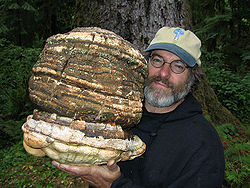Paul Stamets | |
|---|---|
 Stamets holding Laricifomes officinalis in 2006 | |
| Born | July 17, 1955 Salem, Ohio, U.S. |
| Education | Mercersburg Academy |
| Alma mater | The Evergreen State College |
| Subject | Fungi [1] [2] |
| Website | |
| paulstamets | |
Paul Edward Stamets (born July 17, 1955) [3] is an American mycologist and entrepreneur who sells various mushroom products through his company. He is an author and an advocate of medicinal fungi and mycoremediation.